Family : Erebidae

Text © Prof. Santi Longo

English translation by Mario Beltramini
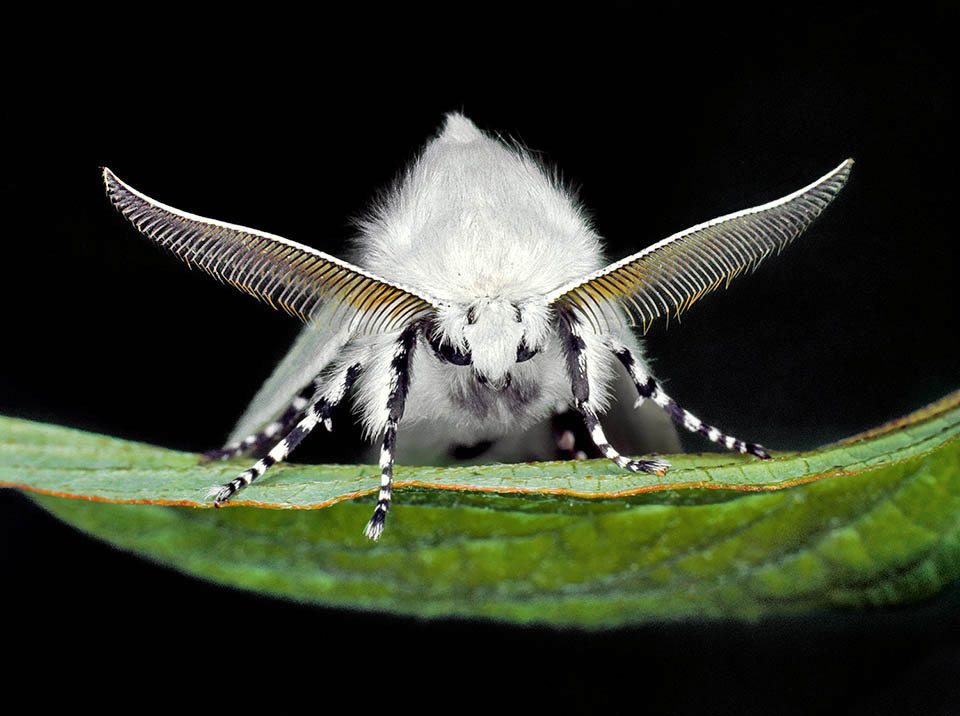
Leucoma salicis male, in the position allowing to catch with the bipectinate antennae the sexual pheromones emitted, even at great distances, by the virgin females © Giuseppe Mazza
The White satin moth, Leucoma salicis (Linnaeus, 1758), is a heteroneide lepidopteran afferent to the family Erebidae.
The name of the genus Leucoma, refers to the colour of the adults from the old Greek “λεύκωμα” (leukoma), candour, whilst the specific term salicis, of the willow in Latin, reminds us that the species of the genus Salix are the host plants preferred by the larvae.
The subfamily Lymantriinae, to which it belongs, includes many species where the two sexes have different dimensions and colours. Their head has no sense organs in the form of bristly relief, called chaetosemata or organs of Jordan; the proboscis of the mouthpart and the ocelli are reduced or absent.
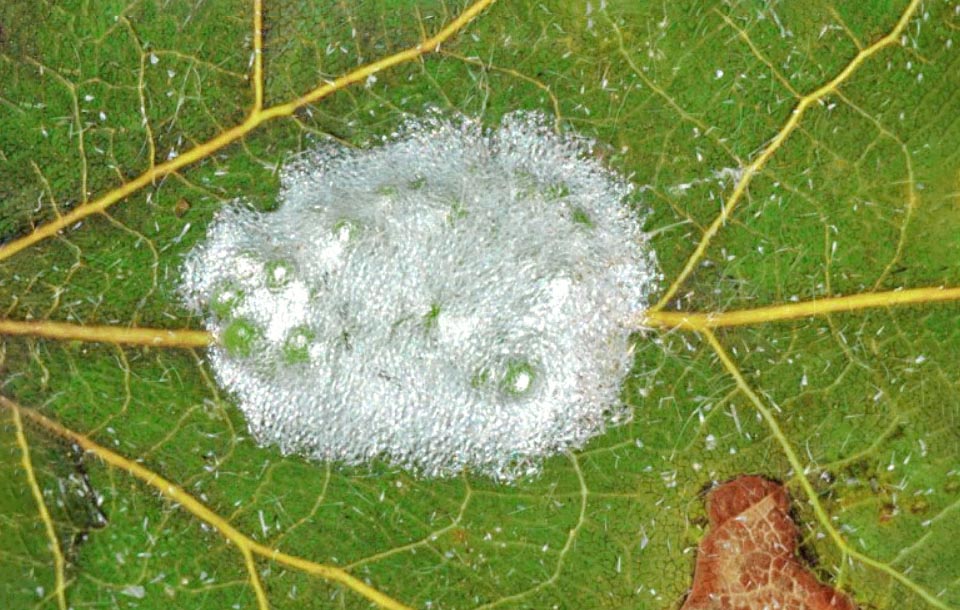
The eggs are laid, one close to the other, side by side and covered by a secretion that confers the whole an unusual foamy appearance © Wolfgang Wagner
In the second segment of the thorax are present the tympanic auditory organs sensitive to the ultrasounds emitted by the bats who are their main predators.
The males go flying during the night, whilst the females are bad fliers and in some species have very reduced wings.
They attract the males emitting sexual pheromones, volatile substances perceived even at considerable distances, and after mating the deposition is compact, in clusters of eggs pressed against each other, called ovatura, and often covered by abdominal hairs or protective secretions.
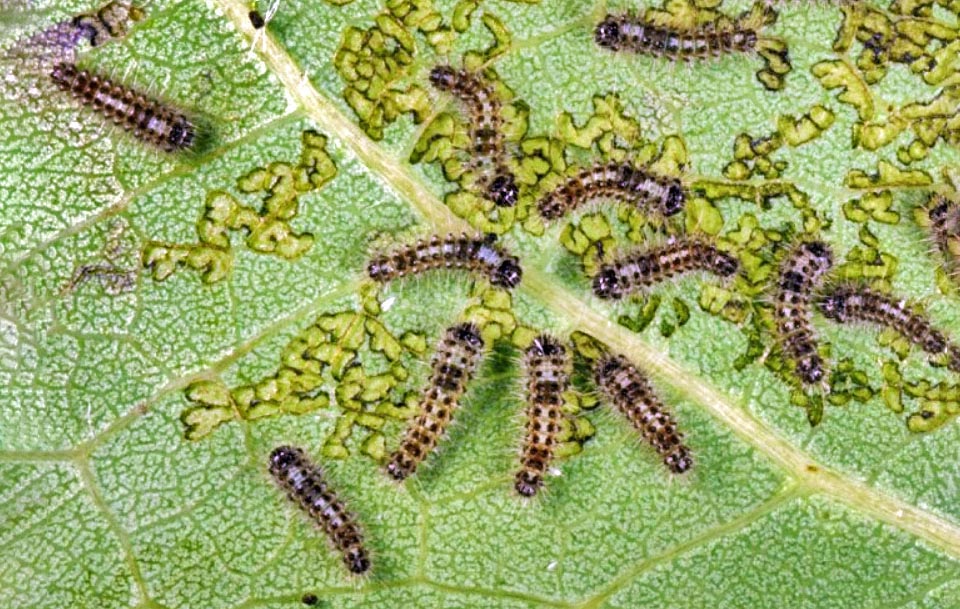
Initially the young larvae keep close and feed at the expense of the leaves epidermis, leaving typical erosions © Wolfgang Wagner
The eruciform larvae, that is characterized by a more or less long and cylindrical body, markedly subdivided in little differentiated metameres with soft tegument, are equipped with a robust chewing mouthpart, with thoracic legs and abdominal pseudo legs. Moreover, they present dorsally some characteristic tubercles, on which are inserted tufts of hairs that in some instances may be urticant.
Species such Lymantria dispar and Euproctis chrysorrhoea, are defoliants of remarkable forest interest. It is curious to observe that these lepidopterans are subject to periodic sudden increases or reductions of their populations, called gradations.
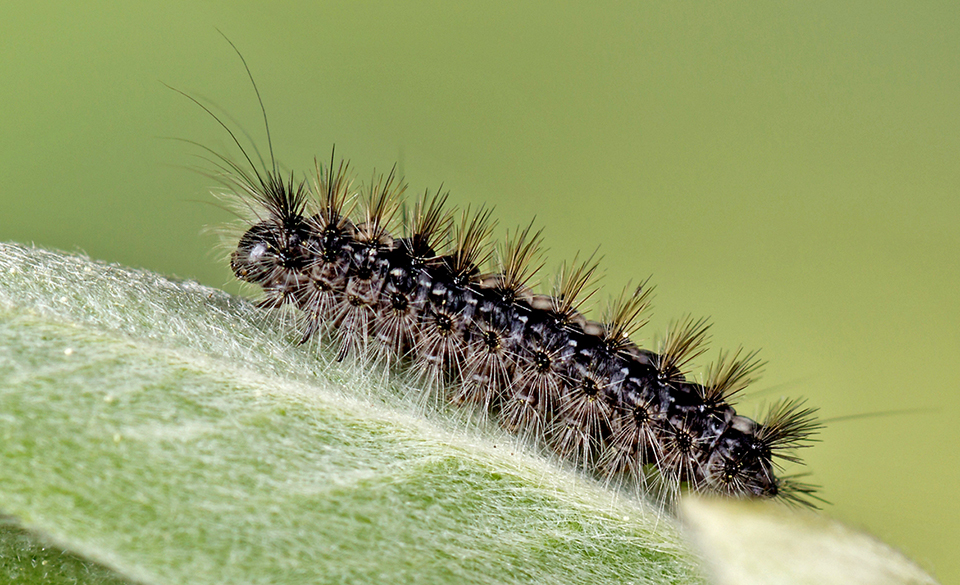
Second age larva. In this solitary phase the colour is black with white spots on the back. Leucoma salicis is diffused in all Europe, in North Africa and in North Asia, up to Korea, Japan and Siberia. Early in the last century it was introduced in North America, where however is not considered invasive due to the numerous natural foes © Nikolai Vladimirov
In this way when their density increases fastly and exponentially we talk of progradation, and when they have reached their peak and regress suddenly of retrogradation. Then follows a phase of latency during which the levels of population are low and whose duration varies in relation to the species and to the environmental conditions.
Leucoma salicis meets irregular increases in the number of individuals that, in forest environments, run out in about five years.
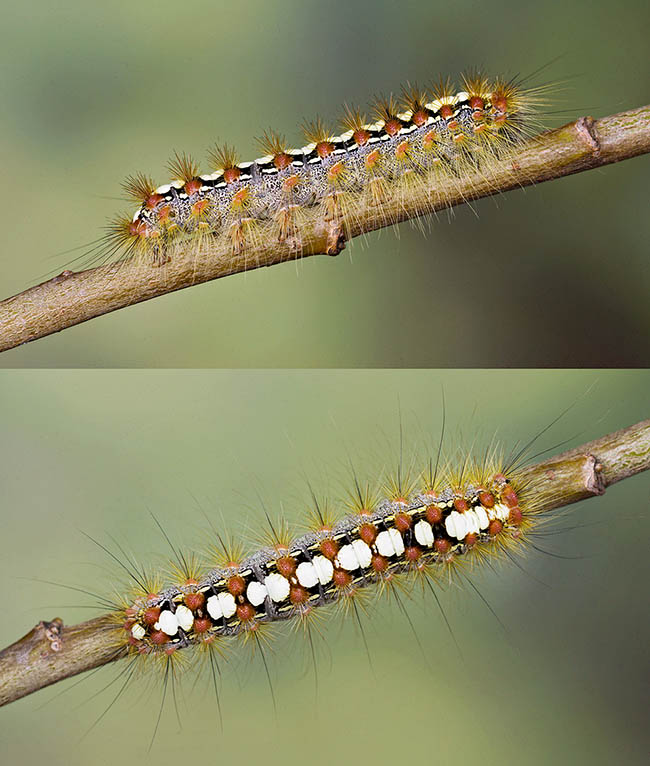
Mature larva, about 5 cm long, seen from side and back to highlight the white spots and the transversal series of red tubercles with tufts of stellate hairs not stinging, unlike other analogous species © Nikolai Vladimirov
In the anthropized zones and especially in the industrial poplar groves, the natural limiting factors are lacking and are not always able to contain the infestations that tend to become recurring. They can prolong several years and often render necessary interventions with insecticides directed against the young larvae.
At the peak of the gradations the foliar erosions done by the mature larvae may skeletonize the whole top of numerous plants.
Zoogeography
The ample diffusion of the White satin moth is testified by the common names with which is indicated in the various Countries where present.
As a matter of fact, the species is known as Whites Satin Moth, to the English-speaking Authors; in France the common name is Bombyx du peuplier; in Germany Pappelspinner; in Sweden Videspinnare and in Italy Falena bianco-argentata del Salice.
Leucoma salicis is diffused all over Europe, in North Africa, in North Asia, up to Korea, to Japan and to Siberia.
At the beginning of the last century it was introduced in North America where, anyway, it is not considered an invasive species because it is controlled by several natural foes.
In Italy it is amply present especially in the northern regions.
In the Etna poplars, at about 2000 m of altitude, Leucoma salicis performs irregular increases of the populations (gradations) that run out over a three-year period.
Ecology-Habitat
Besides attacking willows, the caterpillars of Leucoma salicis affect also the poplars, and, less frequently, birches, oaks, alders, various species of the genus Prunus and the Broussonetia papyrifera, a mulberry of eastern origin, known as Paper mulberry, that has been introduced in Europe in ‘700 as ornamental plant, whilst its wood is utilized in Japan to produce a special type of paper, very thin and resistant.
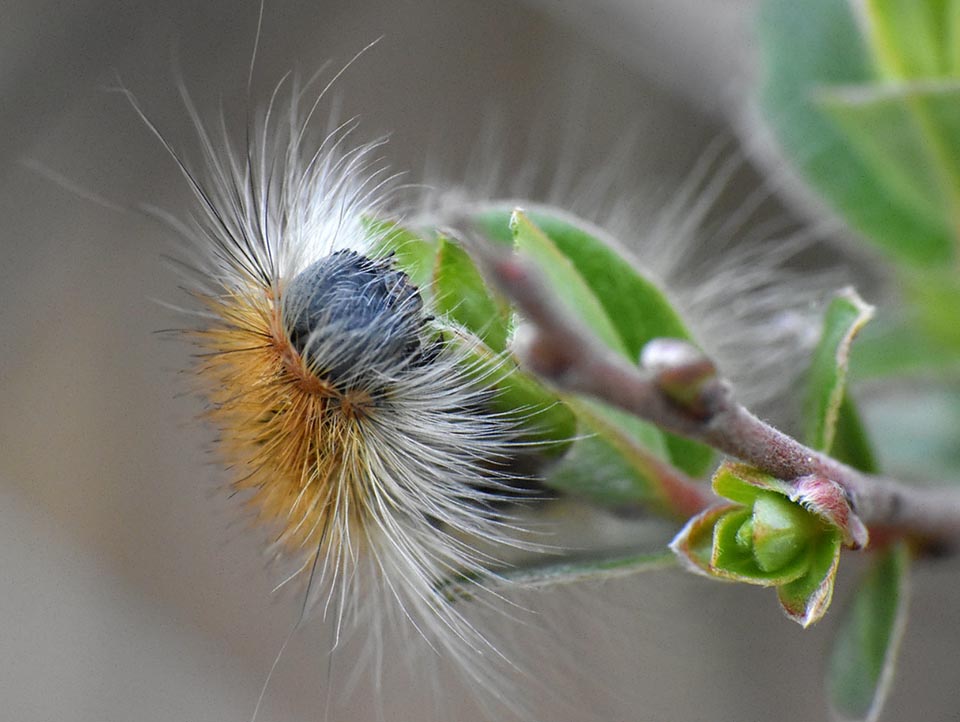
Leucoma salicis doesn’t eat only willow leaves but often affects poplars as well, especially in cultivation, with characteristic recurring cycles © John Gibson
Morphophysiology
The adults of White satin moths have the body of silky white colour; the wingspan of the females, slightly larger in size than those of the males, is of about 5 mm.
The antennae are brownish with white flagellum; those of the females have small teeth, whilst those of the males are long combed. In the legs are present some characteristic black rings. The abdomen is of brown colour, covered by thick white hairs.
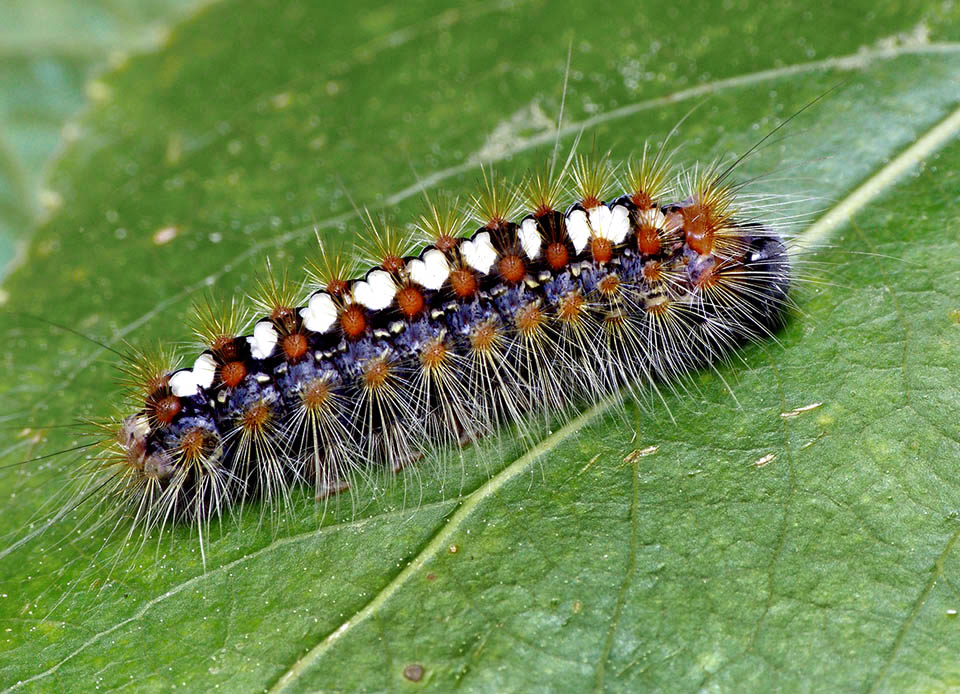
Larvae make five moults. During the last stage, called eopupa, they no longer feed and wander, like this one, looking for a shelter where to pupate © Patrick Clement
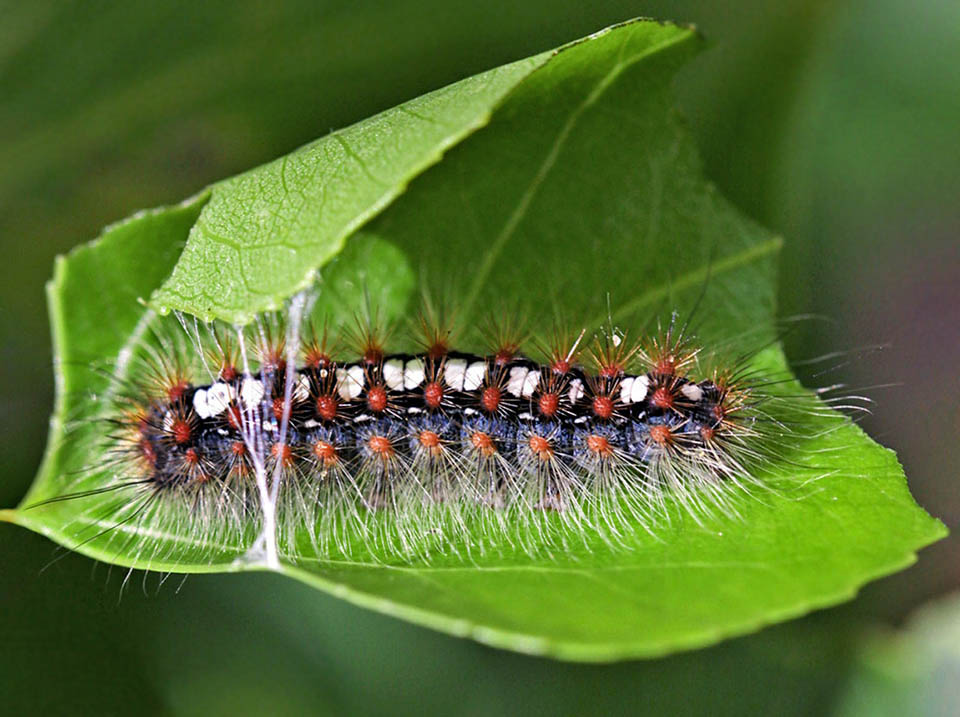
The eopupa, found the suitable place, secretes silky threads produced by the modified salivary glands with which brings near and ties the foliar limbs © Ge van ‘t Hoff
The spherical eggs, compressed in the poles, of about 1 mm of diametre, are of greenish colour and are laid in ovatura.
The young larvae are blackish, the mature ones, about 50 mm long, are of brown reddish colour. The head is black; on the dorsal part of the thorax and of the abdomen are present some characteristic white spots and transverse series of red tubercles with tufts of stellate, brown yellowish, hairs; the lateral areas and the belly are of grey-yellowish colour.
Once completed the larval development, after having done five moults, the last stage, called eopupa, no longer feeds and secretes silk threads with which it binds the leaves forming a sort of shelter where it will transform into chrysalis.
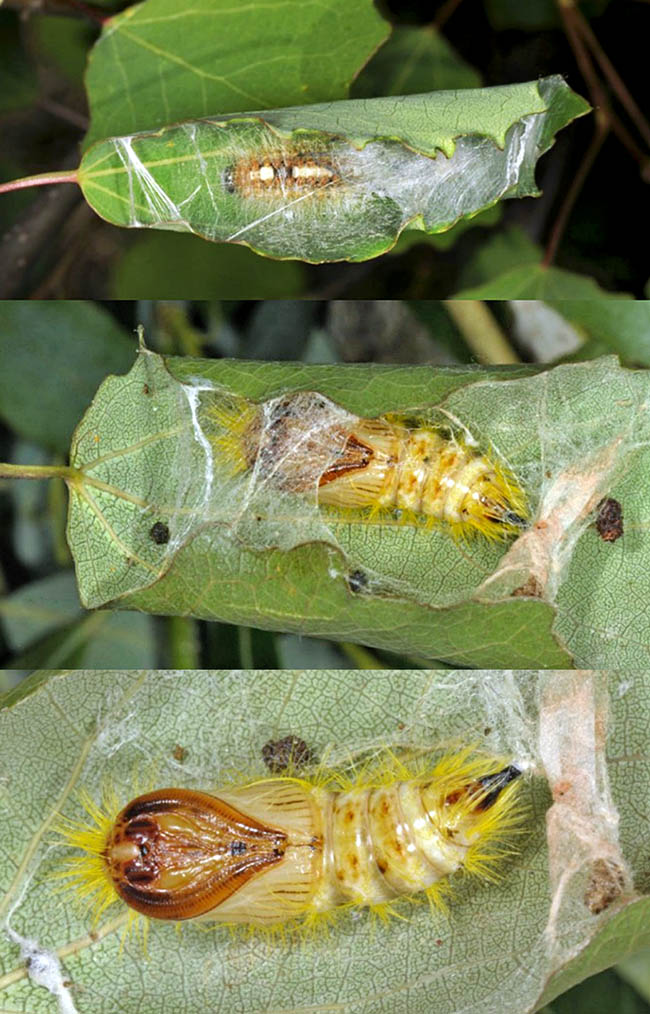
Metamorphosis later stages up to the newly formed chrysalis with not yet hardened tegument © Wolfgang Wagner
The pupa, or chrysalis, is about 20 mm long, if glossy brown black colour, with white spots and tufts of long hairs of yellow colour in those of the females and white in those of the males.
Ethology-Reproductive Biology
Unlike the other species of lepidopterans, the females of the White satin moth, are good fliers and, like the males, are active and emit the volatile substances of sexual appeal (pheromones) during the twilight and the night.
During the day the adults keep motionless on the trunks, on the branches or on the lower pagina of the leaves. If disturbed, they drop to the ground where they remain for some time without taking off for confusing the attackers.
The females, in August-September, after mating, lay on the bark or on the leaves of the plants 100 to 200 eggs close together that cover with the secretion of glands attached to the reproductive system forming in this way some characteristic plaque spawnings of whitish nacreous colour and of foamy appearance.
According to the climatic trend the hatching may take place in autumn or in the following spring.
The larvae born in autumn keep close to each other and secrete sericeous threads with which they realize small silky nests, in the anfractuosities of the bark where they will spend the winter.
They resume the activity in spring for skeletonizing the leaves together with the newborns.
In the following larval ages, they make with their robust jaws ample foliar erosions and, if numerous, they may defoliate the infested plants reducing their woody growth up to bring them, in some rare cases, to death.
The main natural adversities that act on the various stages of the White satin moth are the rain and the snow that damage the winter shelters of the young larvae and the masses of eggs.
Moreover, the natural enemies of this lepidopteran are numerous. The eggs are sought for by the females of the Scelionidae hymenopteran Telenomus nitidulus that put in their own eggs, destroying a large number of them. The larvae and the chrysalises are plundered by the Pentatomid Stink bug Arma custos and by Carabidae Ground beetles, the most important being Calosoma sycophanta.
Active parasitoids of the larvae and of the chrysalises are various Ichneumonid Hymenopterans and Braconidae of the genus Apanteles, as well as Dipterans of the genera Tachina, Compsilura and Carcelia.
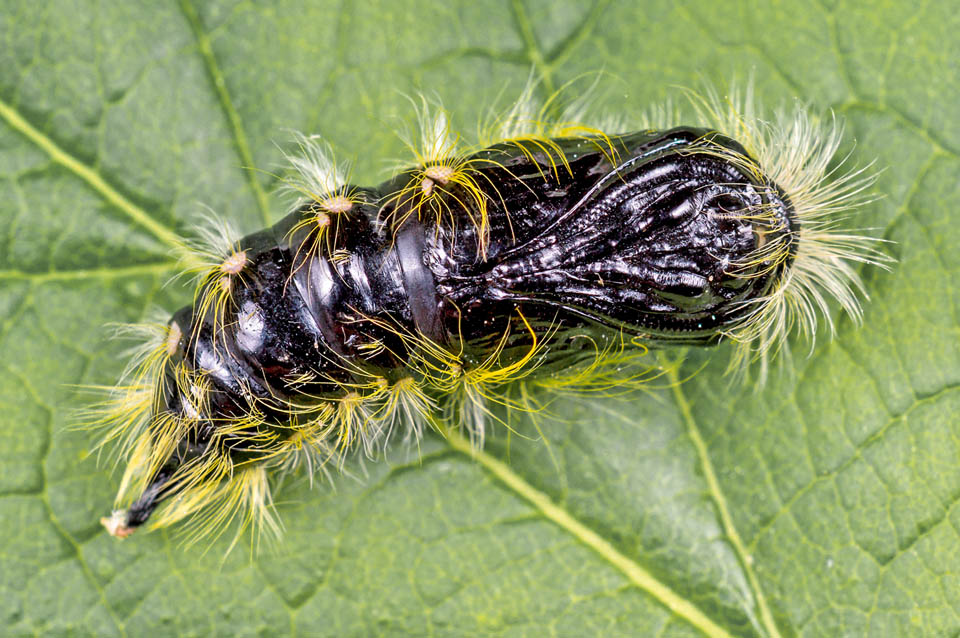
Mature chrysalis. Tegument is glossy black. The females have yellow hairs, whilst they are white in males © Nikolai Vladimirov
The adults are plundered by Bats and by various species of Birds, such as the Common cuckoo (Cuculus canorus) and the Eurasian hoopoe (Upupa epops).
As already mentioned, in unaltered forest environments, the aforementioned biotic and abiotic factors of containment manage to maintain the populations of Leucoma salicis within sustainable limits that, rarely, exceed the threshold of attention in the forest ones.
But in urban environments the species normally develops two annual generations and the scarce effectiveness of the limiting factors does not always manage to contain the recurring infestations; therefore, are necessary insecticidal interventions with chemical or biological formulations, that are regulated by phytosanitary rules.
Synonyms
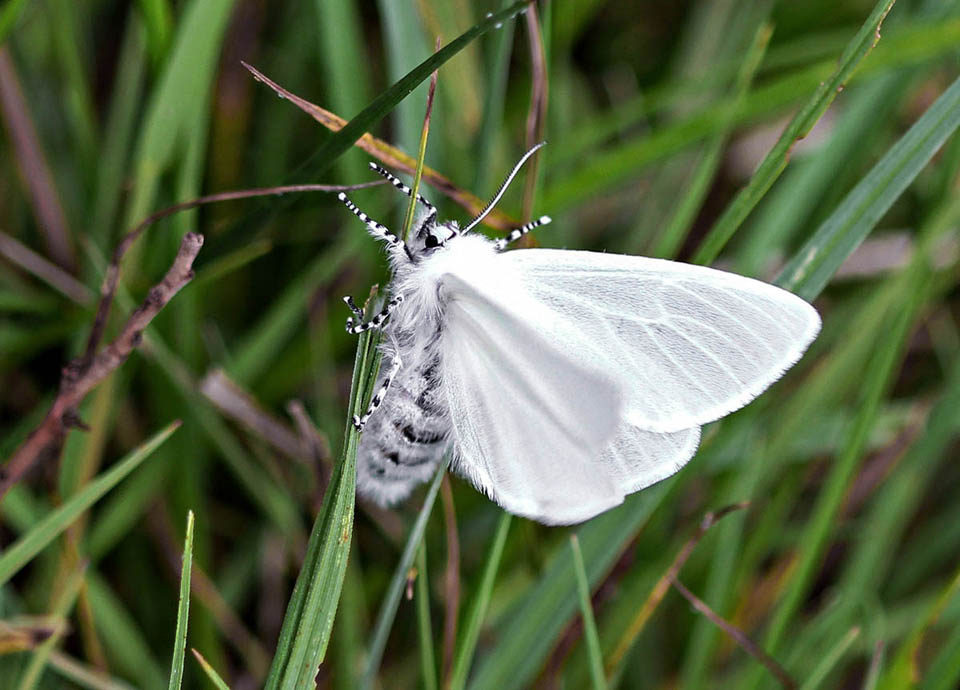
The females fly less than males and have thin antennae with tiny teeth. This species has tympanic hearing organs sensitive to the ultrasound of bats who are their main predators. It is also affected by various species of birds like Cuckoo and Hoopoe. In natura this is sufficient to contain the expansion within sustainable limits that rarely exceed the threshold attention of the forest ones. But in anthropized environments, like industrial poplar groves, are used chemical or biological insecticides against larvae © Colin Gould
The species has been described by Linnaeus in 1758 as Phalaena salicis; was transferred to the genus Leucoma Hubner, 1822 and later on in Laria Schrank,1802; in Stilpnotia Westvood, 1842; in Charala Moor, 1884; in Nymphryxis Grote,1895 and in Candidata Toxopeus, 1948. The 13 synonyms of salicis (Linnaeus 1758) in chronological order are the following: apparens Retzius, 1783; salicinus Haworth, 1803; sohesti Capronnier,1878; nigrociliata Fuchs,1903; xanthocampa Dyar, 1905; rubicunda Strand, 1910; doii Matsumura, 1927; neumanni Bandermann, 1929; coreacola Matsumura,1933; sjoequisti Bryk ; variabilis Bryk, 1949 and infranigricosta Lempke, 1959.
→ For general notions about the Lepidoptera please click here.
→ To appreciate the biodiversity within the BUTTERFLIES please click here.
